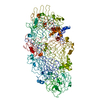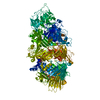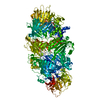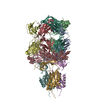+ Open data
Open data
- Basic information
Basic information
| Entry | Database: PDB / ID: 6sup | ||||||
|---|---|---|---|---|---|---|---|
| Title | Crystal Structure of TcdB2-TccC3-Cdc42 | ||||||
 Components Components | TcdB2,TccC3,Cell division control protein 42 homolog | ||||||
 Keywords Keywords | TOXIN / Toxins / Tc Toxins | ||||||
| Function / homology |  Function and homology information Function and homology informationGBD domain binding / Golgi transport complex / positive regulation of pinocytosis / dendritic cell migration / endothelin receptor signaling pathway involved in heart process / cardiac neural crest cell migration involved in outflow tract morphogenesis / storage vacuole / positive regulation of epithelial cell proliferation involved in lung morphogenesis / apolipoprotein A-I receptor binding / neuron fate determination ...GBD domain binding / Golgi transport complex / positive regulation of pinocytosis / dendritic cell migration / endothelin receptor signaling pathway involved in heart process / cardiac neural crest cell migration involved in outflow tract morphogenesis / storage vacuole / positive regulation of epithelial cell proliferation involved in lung morphogenesis / apolipoprotein A-I receptor binding / neuron fate determination / organelle transport along microtubule / regulation of attachment of spindle microtubules to kinetochore / positive regulation of pseudopodium assembly / Inactivation of CDC42 and RAC1 / cardiac conduction system development / host-mediated perturbation of viral process / regulation of filopodium assembly / leading edge membrane / neuropilin signaling pathway / establishment of Golgi localization / GTP-dependent protein binding / adherens junction organization / cell junction assembly / filopodium assembly / establishment of epithelial cell apical/basal polarity / dendritic spine morphogenesis / regulation of lamellipodium assembly / thioesterase binding / regulation of stress fiber assembly / embryonic heart tube development / RHO GTPases activate KTN1 / DCC mediated attractive signaling / regulation of postsynapse organization / CD28 dependent Vav1 pathway / Wnt signaling pathway, planar cell polarity pathway / positive regulation of filopodium assembly / RHOV GTPase cycle / phagocytosis, engulfment / nuclear migration / small GTPase-mediated signal transduction / regulation of mitotic nuclear division / Myogenesis / heart contraction / positive regulation of cytokinesis / spindle midzone / RHOJ GTPase cycle / establishment of cell polarity / RHOQ GTPase cycle / Golgi organization / establishment or maintenance of cell polarity / RHO GTPases activate PAKs / RHOU GTPase cycle / CDC42 GTPase cycle / macrophage differentiation / RHOG GTPase cycle / RAC2 GTPase cycle / RAC3 GTPase cycle / RHO GTPases Activate WASPs and WAVEs / RHO GTPases activate IQGAPs / negative regulation of protein-containing complex assembly / GPVI-mediated activation cascade / positive regulation of lamellipodium assembly / phagocytic vesicle / positive regulation of stress fiber assembly / RAC1 GTPase cycle / EPHB-mediated forward signaling / positive regulation of substrate adhesion-dependent cell spreading / substantia nigra development / Gene and protein expression by JAK-STAT signaling after Interleukin-12 stimulation / actin filament organization / small monomeric GTPase / integrin-mediated signaling pathway / regulation of actin cytoskeleton organization / FCGR3A-mediated phagocytosis / filopodium / EGFR downregulation / RHO GTPases Activate Formins / MAPK6/MAPK4 signaling / Regulation of actin dynamics for phagocytic cup formation / cellular response to type II interferon / VEGFA-VEGFR2 Pathway / cytoplasmic ribonucleoprotein granule / endocytosis / apical part of cell / G beta:gamma signalling through CDC42 / mitotic spindle / ubiquitin protein ligase activity / cell-cell junction / intracellular protein localization / G protein activity / Factors involved in megakaryocyte development and platelet production / actin cytoskeleton organization / positive regulation of cell growth / midbody / positive regulation of phosphatidylinositol 3-kinase/protein kinase B signal transduction / postsynapse / positive regulation of MAPK cascade / neuron projection / positive regulation of cell migration / Golgi membrane Similarity search - Function | ||||||
| Biological species |  Photorhabdus luminescens (bacteria) Photorhabdus luminescens (bacteria) Homo sapiens (human) Homo sapiens (human) | ||||||
| Method |  X-RAY DIFFRACTION / X-RAY DIFFRACTION /  SYNCHROTRON / SYNCHROTRON /  MOLECULAR REPLACEMENT / Resolution: 2 Å MOLECULAR REPLACEMENT / Resolution: 2 Å | ||||||
 Authors Authors | Roderer, D. / Schubert, E. / Sitsel, O. / Raunser, S. | ||||||
| Funding support |  Germany, 1items Germany, 1items
| ||||||
 Citation Citation |  Journal: Nat Commun / Year: 2019 Journal: Nat Commun / Year: 2019Title: Towards the application of Tc toxins as a universal protein translocation system. Authors: Daniel Roderer / Evelyn Schubert / Oleg Sitsel / Stefan Raunser /  Abstract: Tc toxins are bacterial protein complexes that inject cytotoxic enzymes into target cells using a syringe-like mechanism. Tc toxins are composed of a membrane translocator and a cocoon that ...Tc toxins are bacterial protein complexes that inject cytotoxic enzymes into target cells using a syringe-like mechanism. Tc toxins are composed of a membrane translocator and a cocoon that encapsulates a toxic enzyme. The toxic enzyme varies between Tc toxins from different species and is not conserved. Here, we investigate whether the toxic enzyme can be replaced by other small proteins of different origin and properties, namely Cdc42, herpes simplex virus ICP47, Arabidopsis thaliana iLOV, Escherichia coli DHFR, Ras-binding domain of CRAF kinase, and TEV protease. Using a combination of electron microscopy, X-ray crystallography and in vitro translocation assays, we demonstrate that it is possible to turn Tc toxins into customizable molecular syringes for delivering proteins of interest across membranes. We also infer the guidelines that protein cargos must obey in terms of size, charge, and fold in order to apply Tc toxins as a universal protein translocation system. | ||||||
| History |
|
- Structure visualization
Structure visualization
| Structure viewer | Molecule:  Molmil Molmil Jmol/JSmol Jmol/JSmol |
|---|
- Downloads & links
Downloads & links
- Download
Download
| PDBx/mmCIF format |  6sup.cif.gz 6sup.cif.gz | 900.6 KB | Display |  PDBx/mmCIF format PDBx/mmCIF format |
|---|---|---|---|---|
| PDB format |  pdb6sup.ent.gz pdb6sup.ent.gz | 732.8 KB | Display |  PDB format PDB format |
| PDBx/mmJSON format |  6sup.json.gz 6sup.json.gz | Tree view |  PDBx/mmJSON format PDBx/mmJSON format | |
| Others |  Other downloads Other downloads |
-Validation report
| Summary document |  6sup_validation.pdf.gz 6sup_validation.pdf.gz | 409.9 KB | Display |  wwPDB validaton report wwPDB validaton report |
|---|---|---|---|---|
| Full document |  6sup_full_validation.pdf.gz 6sup_full_validation.pdf.gz | 426.8 KB | Display | |
| Data in XML |  6sup_validation.xml.gz 6sup_validation.xml.gz | 41.8 KB | Display | |
| Data in CIF |  6sup_validation.cif.gz 6sup_validation.cif.gz | 68.6 KB | Display | |
| Arichive directory |  https://data.pdbj.org/pub/pdb/validation_reports/su/6sup https://data.pdbj.org/pub/pdb/validation_reports/su/6sup ftp://data.pdbj.org/pub/pdb/validation_reports/su/6sup ftp://data.pdbj.org/pub/pdb/validation_reports/su/6sup | HTTPS FTP |
-Related structure data
| Related structure data |  6suqC  4o9xS S: Starting model for refinement C: citing same article ( |
|---|---|
| Similar structure data |
- Links
Links
- Assembly
Assembly
| Deposited unit | 
| ||||||||
|---|---|---|---|---|---|---|---|---|---|
| 1 |
| ||||||||
| Unit cell |
|
- Components
Components
| #1: Protein | Mass: 240830.547 Da / Num. of mol.: 1 Source method: isolated from a genetically manipulated source Source: (gene. exp.)  Photorhabdus luminescens (bacteria), (gene. exp.) Photorhabdus luminescens (bacteria), (gene. exp.)  Homo sapiens (human) Homo sapiens (human)Gene: tcdB2, TccC3, CDC42 / Production host:  References: UniProt: Q8GF99, UniProt: Q8GF97, UniProt: P60953, small monomeric GTPase | ||||||
|---|---|---|---|---|---|---|---|
| #2: Chemical | | #3: Water | ChemComp-HOH / | Has ligand of interest | N | Has protein modification | Y | |
-Experimental details
-Experiment
| Experiment | Method:  X-RAY DIFFRACTION / Number of used crystals: 1 X-RAY DIFFRACTION / Number of used crystals: 1 |
|---|
- Sample preparation
Sample preparation
| Crystal | Density Matthews: 2.81 Å3/Da / Density % sol: 56.22 % |
|---|---|
| Crystal grow | Temperature: 293.15 K / Method: vapor diffusion, sitting drop / pH: 4.6 Details: 0.1 M sodium chloride, 0.1 M magnesium chloride, 0.1 M tri-sodium citrate pH 5.5, 12 % PEG 4000 Seeding: 0.1 M magnesium chloride, 0.1 M tri-sodium acetate pH 4.6, 12 % PEG 6000 |
-Data collection
| Diffraction | Mean temperature: 100 K / Serial crystal experiment: N |
|---|---|
| Diffraction source | Source:  SYNCHROTRON / Site: SYNCHROTRON / Site:  SLS SLS  / Beamline: X10SA / Wavelength: 0.97958 Å / Beamline: X10SA / Wavelength: 0.97958 Å |
| Detector | Type: PSI PILATUS 6M / Detector: PIXEL / Date: Jun 4, 2017 |
| Radiation | Protocol: SINGLE WAVELENGTH / Monochromatic (M) / Laue (L): M / Scattering type: x-ray |
| Radiation wavelength | Wavelength: 0.97958 Å / Relative weight: 1 |
| Reflection | Resolution: 2→48.17 Å / Num. obs: 182401 / % possible obs: 99.9 % / Redundancy: 22 % / CC1/2: 0.998 / Net I/σ(I): 13.81 |
| Reflection shell | Resolution: 2→2.07 Å / Mean I/σ(I) obs: 1.46 / Num. unique obs: 18014 / CC1/2: 0.688 |
- Processing
Processing
| Software |
| ||||||||||||||||
|---|---|---|---|---|---|---|---|---|---|---|---|---|---|---|---|---|---|
| Refinement | Method to determine structure:  MOLECULAR REPLACEMENT MOLECULAR REPLACEMENTStarting model: 4O9X Resolution: 2→48.17 Å / Cross valid method: FREE R-VALUE
| ||||||||||||||||
| Refinement step | Cycle: LAST / Resolution: 2→48.17 Å
|
 Movie
Movie Controller
Controller












 PDBj
PDBj

















